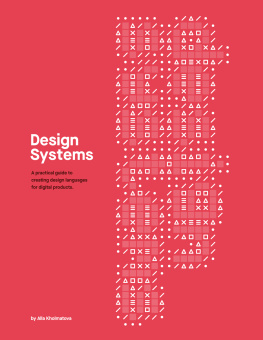Published 2017 by Smashing Media AG, Freiburg, Germany.
All Rights Reserved.
ISBN (ePUB): 978-3-945749-59-3
Cover Design: Espen Brunborg.
Proofreading: Owen Gregory.
eBook production: Cosima Mielke.
Print layout: Markus Seyfferth.
About The Author

Alla Kholmatova is a UX and interaction designer with a nine-year experience of working on the web, for a range of products and companies. Most recently she was a senior product designer at an open education platform, FutureLearn.
Shes particularly interested in design systems, language, and collaborative ways of working. In the last two years this interest has led her to spend a huge amount of time working on and researching the subject. Shes been sharing her insights with people through articles, workshops, and projects. Alla contributes to design publications, such as A List Apart, and speaks at conferences around the world.
About The Reviewers
Karen McGrane has helped businesses create better digital products through the power of user experience design and content strategy for the past twenty years. She is Managing Partner at Bond Art + Science, a UX consultancy she founded in 2006 and formerly VP and National Lead for User Experience at Razorfish. Karen teaches Design Management in the MFA in Interaction Design program at the School of Visual Arts in Manhattan. She co-hosts A Responsive Web Design Podcast with Ethan Marcotte, and her first book, , was published in 2012 by A Book Apart.
Jeremy Keith is co-founder and technical director at Clearleft, a digital design studio based in Brighton, England. When hes not making websites, he talks at conferences about making websites. Sometimes he even writes books about making websites, like the web book at ResilientWebDesign.com that you can have for free. But he mostly spends his time goofing off on the internet, documenting his time-wasting on his website adactio.com where he has been writing for over fifteen years.
http://smashed.by/contentmob
Foreword
If you have a moment, look up the work of artist Emily Garfield. She creates exquisite, intricately detailed maps in watercolor each of them stunning, and each of them depicting a place that doesnt exist. Instead of depicting a citys real, actual landscape, she begins by creating a single, complex pattern a knotted road or twisty river, or a compact grid of city blocks and repeating it. Garfield iterates on that pattern, changing it slightly each time, spiraling out until her not-map is finished. As a result, her art has a generative, fractal-like quality: its built from patterns, yes, but feels part of a cohesive whole.
In fact, Garfield once said, I describe my process as growing the drawing. While reading this wonderful book by Alla Kholmatova this book that youre about to read I thought about that line a lot. Maybe you will, too.
In recent years, web designers have started embracing more modular, pattern-driven design practices. And with good reason: were being asked to create compelling experiences for more screens, more devices, more places, more people than ever before. As a result, weve started to break our interfaces down into tiny, reusable modules, and begun using those patterns to build products, features, and interfaces more quickly than ever before.
But by themselves, design patterns arent enough. They need to live within a larger process, one that ensures these little interface modules feel unified, cohesive, connected. Part of a whole. In other words, they need a design system to thrive and thats where Allas book comes in.
In these pages, Alla shows us precisely how to create systems to support our digital designs. With clear writing, case studies, and detailed examples, Alla shows us how to establish a common, shared language among our teams, which allows us to more effectively collaborate; shell tell stories of how different organizations have created their design systems, and put them into practice; and shell discuss different models for evolving these systems over time.
In other words, this isnt just a book. Alla has drawn a clear, bright map for us, one that outlines a more sustainable model for digital design. And if we walk the paths shes drawn for us, well learn to grow better design systems and with them, better designs.
Ethan Marcotte
Introduction
What This Book Is About
As the web continues to change rapidly and become more complex, thinking of it in terms of static pages has become untenable, and many of us have started to approach design in a more systematic way.
And yet not all design systems are equally effective. Some can generate coherent user experiences, others produce confusing patchwork designs. Some inspire teams to contribute to them, others are neglected. Some get better with time, more cohesive and better functioning; others get worse, becoming bloated and cumbersome.
What are the key qualities of a well-functioning, enduring design system? This question intrigued me so much I spent a huge amount of time researching and thinking about it. My research and thoughts provide the basis of this book. Drawing on the experience of companies of various sizes and approaches to design systems, I set out to identify what makes an effective system that can empower teams to create great digital products. Throughout the book Ill share an approach that helps me every day with my work. I hope this will help with your work, too.
Who This Book Is For
This book is aimed mainly at small and medium-sized product teams trying to integrate design systems thinking into their organizations culture. Everyone in the product team could benefit from reading this book, but particularly visual and interaction designers, UX practitioners and front-end developers.
Scope Of The Book
This book presents a perspective on design systems based on my experience as an interaction and visual designer. I dont touch on other related areas, such as information architecture, content strategy or design research. Equally, this is not a technical book. You wont find any code samples or in-depth analysis of development tools and techniques, although there will be plenty of discussion directly related to front-end practices.
This is a design book, but it isnt about what to design. Neither is it an attempt to create a comprehensive guide to designing digital products. It is about how to approach your design process in a more systematic way, and ensure your design system helps to achieve the purpose of your product and fits with the culture of your team.
How This Book Is Organized
The book has two parts.
Part 1: Foundations
In the first part well talk about the foundations of a design system patterns and practices. Design patterns are repeatable, reusable parts of the interface, from the concrete and functional (like buttons and text fields) to the more descriptive (like iconography styles, colors and typography). Patterns interconnect, and together they form the









